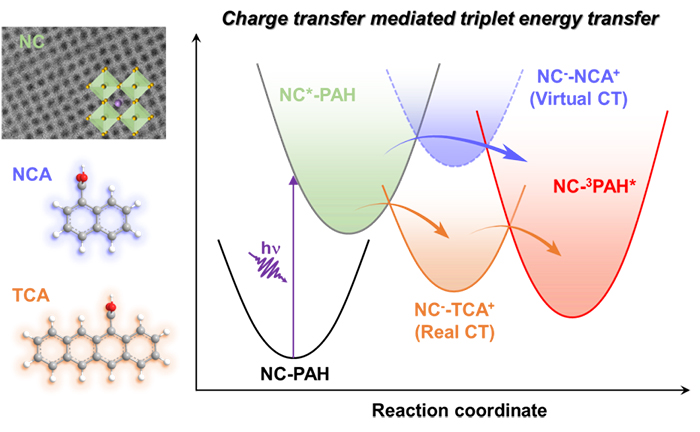A research group led by Prof. WU Kaifeng from the Dalian Institute of Chemical Physics (DICP) of the Chinese Academy of Sciences (CAS) recently reported their latest progress on the mechanisms of triplet energy transfer across the inorganic /organic interface. By building model systems with well-defined interfacial energetics based on lead halide perovskite nanocrystals and polycyclic aromatic hydrocarbons (PAHs), and using femtosecond laser spectroscopy, they revealed a unified picture of “charge transfer mediated triplet energy transfer” (CT-mediated TET). The results were recently published on Nat. Commun.

A unified picture of real versus virtual CT-mediated TET mechanisms across the inorganic nanocrystal/organic molecule interface.
Molecular spin-triplet states (hereafter called “triplets”) have been an important subject of research in photochemistry for many decades, because of their broad applications ranging from photoredox catalysis to photodynamic therapy and to photon management. These optically “dark” triplets cannot be directly populated using light and needs to be sensitized via a process called triplet energy transfer (TET).
Recently inorganic semiconductor nanocrystals (NCs) have emerged as a novel type of triplet sensitizers because of their excellent light-capturing capability and small intersystem crossing energy loss in these NCs.
The literature to date, however, is very vague regarding the detailed mechanisms of TET from inorganic NCs to organic molecules. Some studies report a direct, two-electron exchange mechanism (called Dexter mechanism), while other studies show evidence for TET mediated by charge transfer states. There are also claims on NC surface defect states mediated TET. Thus, clarifying the mechanism and even establishing a unified picture is very essential for this field.
In recognition of the above-mentioned complexities, the WU group decided to build model systems using highly-emissive lead halide perovskite nanocrystals as the triplet donor and polycyclic aromatic hydrocarbons (PAHs) as the acceptor.
The high emissivity of the perovskite NCs help excluding a major impact from surface defect states. The interfacial energetics between the NCs and PAHs are carefully determined in order to predict whether charge transfer is energetically allowed or inhibited.
Detailed femtosecond laser spectroscopy studies establish that in the case of tetracene as the acceptor, where hole transfer from NCs to tetracene is energetically favoured, TET is mediated by a real charge separated state, whereas “direct” TET is observed for the naphthalene system because charge transfer processes are energetically uphill.
Notably, however, the “direct” TET is also likely mediated through a high-energy, virtual charge-transfer state, because of the participation of this virtual state strongly enhances the electronic coupling required for charge/energy transfer.
The unified picture of real versus virtual CT-mediated TET mechanisms paves the way for rationally designing the energetics at the inorganic semiconductor/organic molecule interface for high-efficiency TET important for many emerging applications.
This work was supported by the Ministry of Science and Technology of China, CAS, the National Natural Science Foundation of China and the LiaoNing Revitalization Talents Program. The paper is dedicated to DICP, CAS, on the occasion of its 70th anniversary. (Text and Image by LUO Xiao).